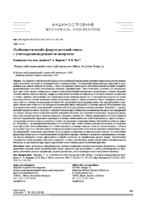Особенности изгиба фторопластовой ленты с учетом разномодульности материала
Another Title
Specific Features of Fluoroplastic Band Bending with Due Account of Various Modularity of Material
Bibliographic entry
Вершина, Г. А. Особенности изгиба фторопластовой ленты с учетом разномодульности материала = Specific Features of Fluoroplastic Band Bending with Due Account of Various Modularity of Material / Г. А. Вершина, Л. Е. Реут // Наука и техника. – 2019. – № 3. – С. 185-194.
Abstract
Рассмотрен технологический процесс изготовления фторопластовых уплотнительных колец путем наматывания ленточной заготовки на цилиндрическую оправку-калибр с последующей выдержкой под нагрузкой и дальнейшим разрезанием спирали на кольца, а также исследована возможность получения изделий методом холодного формоизменения заготовки, исключающая операцию термофиксации. Такая технология, учитывая, что фторопласт даже при очень низких температурах является высокопластичным материалом, представляется вполне реальной. Поэтому намотка ленты на оправку, выдержка спиральной заготовки без нагрева, но в условиях силового воздействия в течение времени, необходимого для завершения релаксационных процессов, и последующая разрезка на кольца позволят получать готовые кольцевые изделия требуемых размеров. Однако фторопласт имеет специфику механических свойств и обладает целым рядом особенностей, проявляемых при деформировании. Его деформационное поведение значительно отличается от поведения низкомолекулярных материалов, а поэтому требует обоснованного подхода при использовании существующей теоретической базы и разработке расчетных методик. Фторопласт – высокоплотный материал и имеет структуру с высокой степенью кристалличности, механизм протекания в нем деформаций в условиях силового поля во многом подобен поведению металлов, что позволяет использовать для расчета фторо-пластовых изделий методы и подходы, принятые в механике твердых тел. Однако применяемые расчетные формулы требуют определенной коррекции и адаптации к особенностям механических свойств фторопласта, одна из которых – его различная жесткость при растяжении и сжатии, что проявляется при наматывании ленточной заготовки на оправку. Фторопласт – разномодульный материал, его жесткость при сжатии больше, чем при растяжении, и вследствие этого при изгибе ленты нейтральная ось сечения смещается от центра тяжести в область сжатых волокон, а область растяжения возрастает. Высокая упругость при растяжении и возрастание этой области приводят к накоплению упругих деформаций, вызывающих пружинение после разгрузки и изменение размеров готового изделия. Это необходимо предусмотреть при расчете и проектировании инструмента-оправки, учитывая в формулах разномодульность материала или рассматривая сечение, приведенное к единой жесткости, но принимающее другую форму. Разработанные авторами расчетные методики для обоих вариантов сечения, учитывающие прямо или косвенно разномодульность материала, не противоречат друг другу и достаточно точно подтверждаются опытными данными.
Abstract in another language
The paper considers a technological process for production of sealing rings by winding a band work-piece on a cylindrical caliber mandrel with subsequent endurance under load and further cutting of a spiral in rings and also studies the possibility to obtain products while using a method for cold forming of a work-piece which excludes thermal stabilization operation. Taking into account the fact that fluorine plastic is a high-plastic material even at very low temperatures such technology looks quite real. Therefore winding of a band on a mandrel, endurance of a spiral work-piece without heating but under conditions of force action within the time which is necessary for completion of relaxation processes, and the subsequent cutting in rings will allow to obtain finished ring products of the required size. However fluoroplastic has specific mechanical properties and a number of specific features which are revealed during deformation process. Its deformation behavior considerably differs from behavior of low-molecular materials and therefore it requires a solid approach while using the existing theoretical base and developing calculation methodologies. While taking into consideration the fact that fluorine plastic is high density material and has structure with high degree of crystallinity, the mechanism of deformation behavior in it under conditions of a force field is mainly similar to metal behavior that allows to use methods and approaches for calculation of fluoroplastic products which are accepted in mechanics of solid bodies. However the applied calculating formulae require a certain correction and adaptation to specific features of mechanical fluoroplastic properties, one of which is its various rigidity at stretching and compression that is revealed in case of winding band work-piece on a mandrel. Fluorine plastic is a material with various modularity and its rigidity is higher during compression than under stretching and consequently in the case of band bending a neutral axis of section is displaced from the center of gravity to the area of compressed fibers, and the area of stretching is increasing. High elasticity at stretching and increase of this area lead to large accumulation of elastic deformations causing springing after unloading and changes in size of a finished product. These facts must be taken into account while calculating and designing a mandrel tool, it is also necessary to keep in mind various modularity of a material and possibility that a section being led to an uniform rigidity may take some other shape due to this. Calculation methodologies have been developed by the authors for both versions of section that take into consideration directly or indirectly a material with various modularity and which do not contradict each other and which are rather precisely proved by experimental data.
View/
Collections
- № 3[10]

